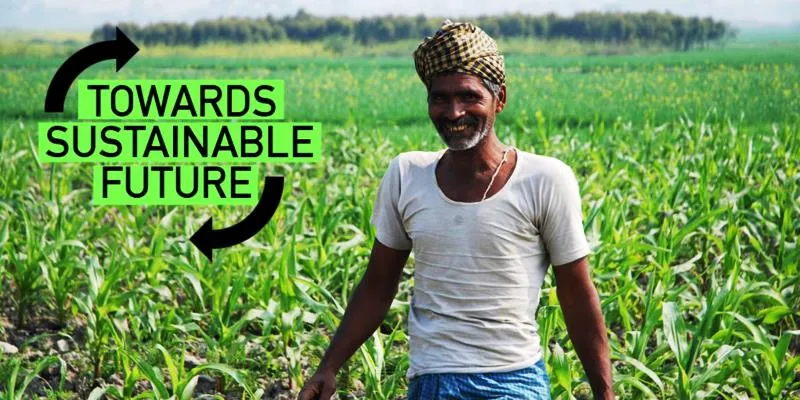Kedia, a village in Bihar, shows the way forward in ecological agriculture
“A nation that destroys its soils destroys itself.” – Franklin Roosevelt
Just like good food nourishes the human body, healthy soil nourishes plants. When a human being is well nourished, he/she acquires a high immunity and capacity to fight off diseases and ailments. Likewise, when a plant is well nourished, its immunity is dramatically improved, and it has a high capacity to fight off pests and diseases, thereby reducing and often eliminating the need for pesticides. Like a healthy human being does not need medication, when soil is healthy, it requires little or no chemical inputs such as fertiliser.

It is with this fundamental understanding that Kedia, a village tucked in Bihar’s Jamui district started its journey away from agro-chemicals such as pesticides and chemical fertilisers a little over two years ago.
Kedia adopted a combination of physical and biological measures such as soil improvement and complemented that with eco-friendly bio-pesticides to eliminate the need for chemical pesticides and fertilisers. Physical measures include the addition of biomass (cow dung, crop residue, or leaf manure) to the soil. Biomass is converted into vermin-compost, for which vermin-compost beds have been set up across the village. Vermin-compost is made with the help of earthworms, which are referred to as the farmer’s best friends, and with good reason. They breakdown biomass into extremely rich manure, which when added to the soil, adds nutrients that are easily available to plants. This not only increases the nutrient value of the food, but enables the plant to ward off insects by way of increased immunity.
Likewise, concrete cattle sheds have been set up at multiple locations. This enables villagers to easily collect cow dung and cow urine, which are used in preparations for soil health improvement and pest control.
Biogas plants have also been set up. While earlier, cow dung was being dried into cakes and used as cooking fuel, with the setting up of the biogas plant, dung is directly dumped into the plant, and converted to cooking gas. This also prevents indoor pollution, a by-product of dried dung cakes, and this has improved the health of women and children who primarily spend time indoors. Leachate, a primary by-product of the biogas plant, is an extremely strong and effective liquid fertiliser, which is also used to improve soil health.
Eco-san toilets or biological toilets, which separate human urine from excreta as good manure allows the use of both as very effective fertiliser. The social benefit of this is huge. It ensures that women have safe toilets that they can access at any point in the day or night, and also reduces open-defecation-related trauma.
Bio-pesticides are used making locally available plants, cow dung, urine, ghee, channa atta, and curd among other things. These are effectively sprayed over the plants to reduce pest attack. Additionally, multi-cropping, is being practised. This is an extremely strong counter to pests. When companion plants are planted, insects from one control insects that could harm the other. This way there is a perfect system of checks and balances. In the event of crop loss due to increased temperatures or a sudden disease, one crop will survive and the farmer would not have lost everything. The greater the diversity on the field and on our plates, the higher the possibility of food and nutritional security.

Likewise, the planting of indigenous trees close to the field not only adds to biomass by way of leaf residue and shade, but also increases the soil moisture. The birds that the tree attract act as pest control agents by eating up all the insect food available in nearby fields. Trees also act as physical barriers and prevent top soil, which takes millions of years to get formed, from getting eroded.
All the physical structures, which have been set up – bio-gas plants, vermin-compost beds, eco-san toilets, and pukka cattle sheds are made by tapping into existing Government schemes. Since all these add to soil health improvement and agriculture directly, it’s best these are converged under one roof to make access easier. Despite the subsidy, it would be very difficult for marginal farmers to bear the cost of the subsidy, making it impossible to pay at the beginning.
While there are challenges in the application process, the benefits are immense. Costs for over 92 percent of farmers have gone down. Pesticide usage has gone down by 100 percent! Fertiliser usage has nearly halved. Reduced agro-chemicals means safer food. The soils capacity to recycle nutrients has also increased, which means the food should have higher levels of nutrition. Biodiversity is returning to the region. Birds, butterflies, frogs, earthworms. Levels of moisture in the soil have increased. And so has the resilience, which with the newly acquired immunity, is more resilient to variations in climate.
The villagers are now looking for support to set up an eco-frost freezer, which will be solar-powered and play an important role in storing the ecologically cultivated produce from the village. This will help reduce food loss. Globally, a third of the food grown is lost. And countries such as ours lose much of the food between cultivation and distribution.
Kedia is a story of resilience. It is a story of hope. And it goes to prove what the FAO has been trying to drive at – that small and marginal farmers can feed the world. And that safe food (sans agro-chemicals and Genetically Modified Organisms) for all can be real. And without costing us the planet.







